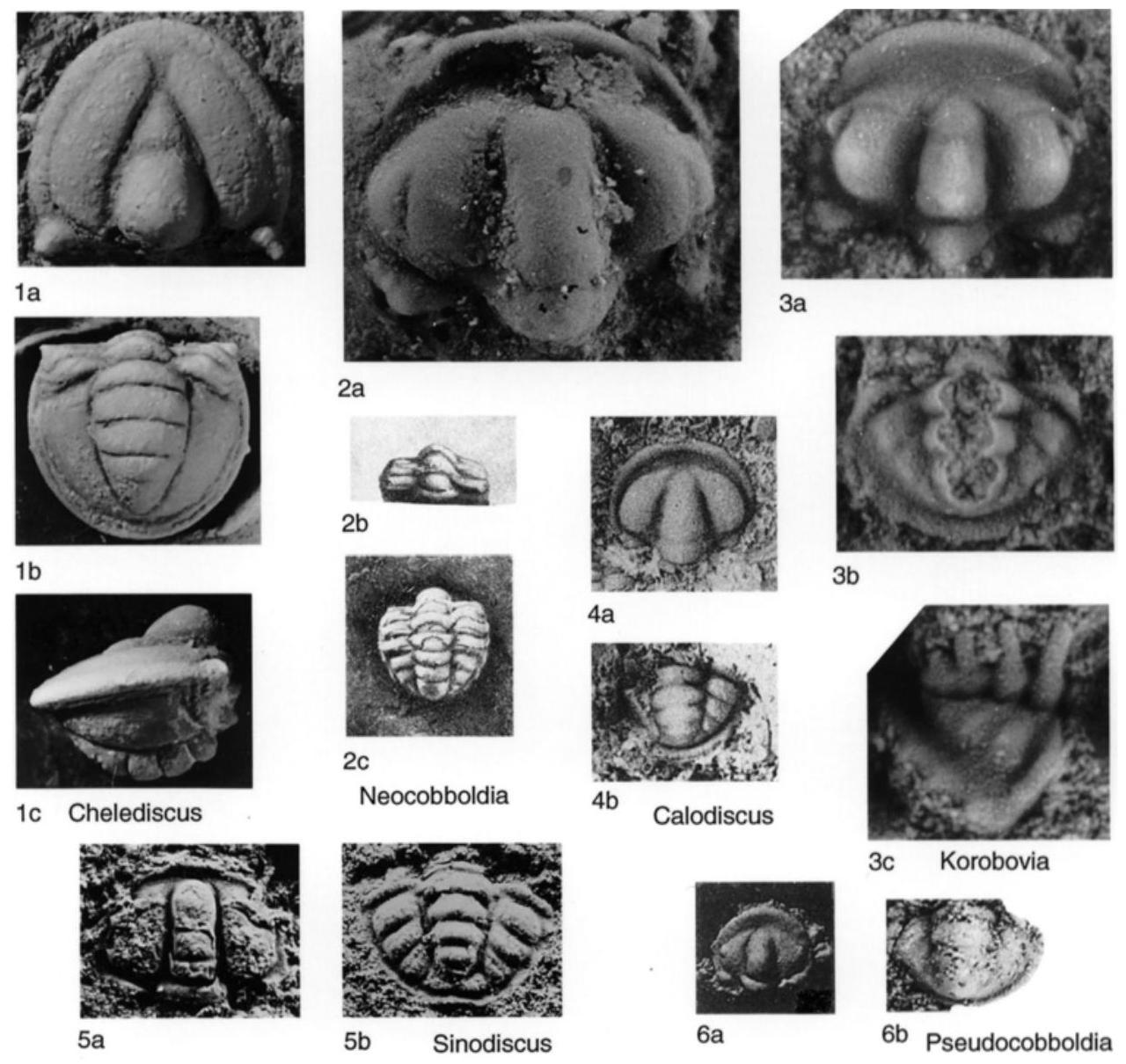Welcome to the Treatise on Invertebrate Paleontology!
Please enter a genera name to retrieve more information.

Neocobboldia
Classification
Phylum:
Arthropoda
Class:
Trilobita
Order:
Agnostida
Superfamily:
Eodiscoidea
Family:
Calodiscidae
Formal Genus Name and Reference:
Neocobboldia Rasetti, 1952a, p. 438, nom. nov. pro Cobboldia Lermontova, 1940, p. 120, non Brauer, 1887, nec LEIPER, 1910
Type Species:
Cobboldia dentata Lermontova, 1940, p. 120, OD, holotype (LERMONTOVA, 1951a, pl. 3, fig. 2) 23/5156, TsGM, St. Petersburg
Images
(Click to enlarge in a new window)
Fig. 245,2a–c. *N. dentata, Lower Cambrian (Protolenus Zone), Siberia (Lena River, Yakutia); a, holotype, cranidium, ×6.5; b,c, thorax and pygidium, ×6.5 (Lermontova, 1951a).
Synonyms
Margodiscus
Geographic Distribution
Russia (Siberian Platform, Gorno-Altayskaya), Mongolia
Age Range
Beginning Stage in Treatise Usage:
Lower Cambrian (“Lower Cambrian” in Trilobite volume of Treatise = current Cambrian Epoch 2 of international scale) (Botomian)
Beginning International Stage:
Cambrian Stage 3
Fraction Up In Beginning Stage:
75
Beginning Date:
516.13
Ending Stage in Treatise Usage:
Lower Cambrian (“Lower Cambrian” in Trilobite volume of Treatise = current Cambrian Epoch 2 of international scale) (Botomian)
Ending International Stage:
Cambrian Stage 4
Fraction Up In Ending Stage:
25
Ending Date:
513.13
Description
Glabella parallel sided, anteriorly rounded at border furrow, unfurrowed except for well-impressed, transverse SO, fixigenae narrow, separated anteriorly by short, depressed median preglabellar field, border furrow usually longer than border, anterior border short, convex, tapering only slightly laterally, palpebral furrow slitlike, exsagittal, short. Pygidium transverse, axis wide, of 3 or 4 rings plus terminus, finishing at border furrow, pleural areas usually with well-impressed pleural furrows, border narrow, denticulate.
References
Museum or Author Information
Classification
Phylum:
Arthropoda
Class:
Trilobita
Order:
Agnostida
Superfamily:
Eodiscoidea
Family:
Calodiscidae
Formal Genus Name and Reference:
Neocobboldia Rasetti, 1952a, p. 438, nom. nov. pro Cobboldia Lermontova, 1940, p. 120, non Brauer, 1887, nec LEIPER, 1910
Type Species:
Cobboldia dentata Lermontova, 1940, p. 120, OD, holotype (LERMONTOVA, 1951a, pl. 3, fig. 2) 23/5156, TsGM, St. Petersburg
Images
(Click to enlarge in a new window)
Fig. 245,2a–c. *N. dentata, Lower Cambrian (Protolenus Zone), Siberia (Lena River, Yakutia); a, holotype, cranidium, ×6.5; b,c, thorax and pygidium, ×6.5 (Lermontova, 1951a).
Synonyms
Margodiscus
Geographic Distribution
Russia (Siberian Platform, Gorno-Altayskaya), Mongolia
Age Range
Beginning Stage in Treatise Usage:
Lower Cambrian (“Lower Cambrian” in Trilobite volume of Treatise = current Cambrian Epoch 2 of international scale) (Botomian)
Beginning International Stage:
Cambrian Stage 3
Fraction Up In Beginning Stage:
75
Beginning Date:
516.13
Ending Stage in Treatise Usage:
Lower Cambrian (“Lower Cambrian” in Trilobite volume of Treatise = current Cambrian Epoch 2 of international scale) (Botomian)
Ending International Stage:
Cambrian Stage 4
Fraction Up In Ending Stage:
25
Ending Date:
513.13
Description
Glabella parallel sided, anteriorly rounded at border furrow, unfurrowed except for well-impressed, transverse SO, fixigenae narrow, separated anteriorly by short, depressed median preglabellar field, border furrow usually longer than border, anterior border short, convex, tapering only slightly laterally, palpebral furrow slitlike, exsagittal, short. Pygidium transverse, axis wide, of 3 or 4 rings plus terminus, finishing at border furrow, pleural areas usually with well-impressed pleural furrows, border narrow, denticulate.
